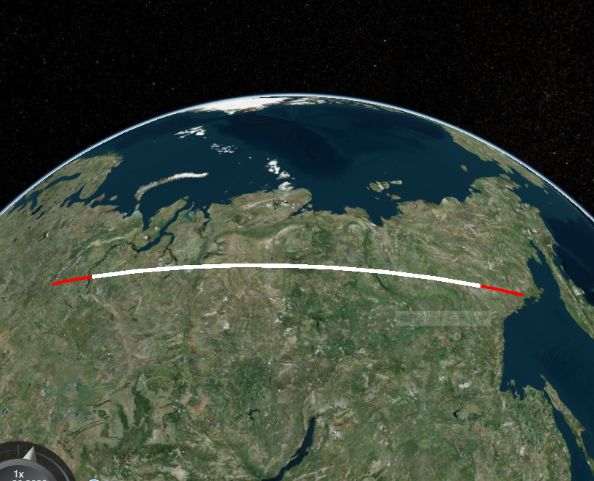3D曲面上,两点的距离求解不能采用欧式距离,而需要计算测地线距离。
代码使用CGAL 5.6.2 + OpenCV 4.11.0 版本实现

cpp
#include "cgal_utils.h"
#include <CGAL/AABB_tree.h>
#include <CGAL/AABB_traits.h>
#include <CGAL/AABB_face_graph_triangle_primitive.h>
#include <CGAL/Surface_mesh_shortest_path.h>
#include <CGAL/boost/graph/graph_traits_Surface_mesh.h>
// 将CGAL点转换为glm::dvec3
glm::dvec3 cgal_utils::cgalToGLM(const cgal_utils::Point_3& p) {
return glm::dvec3(CGAL::to_double(p.x()),
CGAL::to_double(p.y()),
CGAL::to_double(p.z()));
}
// 将glm::dvec3转换为CGAL点
cgal_utils::Point_3 cgal_utils::glmToCGAL(const glm::dvec3& p) {
return cgal_utils::Point_3(p.x, p.y, p.z);
}
// 将glm::dvec3转换为CGAL点
std::vector<cgal_utils::Point_3> cgal_utils::convertToCGALPoints(const std::vector<glm::dvec3>& points) {
std::vector<Point_3> cgalPoints;
cgalPoints.reserve(points.size());
for (const auto& p : points) {
cgalPoints.emplace_back(p.x, p.y, p.z);
}
return cgalPoints;
}
// 计算凸包并返回Polyhedron
cgal_utils::Polyhedron_3 cgal_utils::computeConvexHullAsPolyhedron(const std::vector<glm::dvec3>& inputPoints)
{
// 转换点格式
std::vector<cgal_utils::Point_3> points = convertToCGALPoints(inputPoints);
// 计算凸包
cgal_utils::Polyhedron_3 poly;
CGAL::convex_hull_3(points.begin(), points.end(), poly);
return poly;
}
// 计算凸包并返回Surface_mesh
cgal_utils::Surface_mesh cgal_utils::computeConvexHullAsSurfaceMesh(const std::vector<glm::dvec3>& inputPoints) {
// 转换点格式
std::vector<cgal_utils::Point_3> points = convertToCGALPoints(inputPoints);
// 计算凸包
cgal_utils::Surface_mesh mesh;
CGAL::convex_hull_3(points.begin(), points.end(), mesh);
return mesh;
}
// 保存Polyhedron到OFF文件
void cgal_utils::savePolyhedronToOFF(const cgal_utils::Polyhedron_3& poly, const std::string& filename) {
std::ofstream out(filename);
out << poly;
out.close();
}
// 保存Surface_mesh到OFF文件
void cgal_utils::saveSurfaceMeshToOFF(const cgal_utils::Surface_mesh& mesh, const std::string& filename) {
std::ofstream out(filename);
out << mesh;
out.close();
}
// 计算每个点到凸包的最近点
std::vector<glm::dvec3> cgal_utils::computeClosestPointsOnHull(
const std::vector<glm::dvec3>& inputPoints,
const cgal_utils::Surface_mesh& convexHull) {
// 创建AABB树用于最近点查询
typedef CGAL::AABB_face_graph_triangle_primitive<Surface_mesh> Primitive;
typedef CGAL::AABB_traits<K, Primitive> Traits;
typedef CGAL::AABB_tree<Traits> Tree;
Tree tree(faces(convexHull).first, faces(convexHull).second, convexHull);
tree.accelerate_distance_queries();
std::vector<glm::dvec3> closestPoints;
closestPoints.reserve(inputPoints.size());
for (const auto& p : inputPoints) {
Point_3 query = cgal_utils::glmToCGAL(p);
Point_3 closest = tree.closest_point(query);
if (isnan(closest.x()))
std::cout << "nan" << std::endl;
closestPoints.push_back(cgalToGLM(closest));
}
return closestPoints;
}
// 计算测地线距离矩阵
cv::Mat cgal_utils::computeGeodesicDistances(
const std::vector<glm::dvec3>& points,
const cgal_utils::Surface_mesh& mesh) {
// 创建距离矩阵
cv::Mat distanceMatrix(points.size(), points.size(), CV_64F);
// 创建最短路径计算对象
typedef CGAL::Surface_mesh_shortest_path_traits<K, Surface_mesh> Traits;
typedef CGAL::Surface_mesh_shortest_path<Traits> Shortest_path;
typedef typename Shortest_path::Face_location Face_location;
typedef CGAL::AABB_face_graph_triangle_primitive<Surface_mesh> AABB_face_graph_primitive;
typedef CGAL::AABB_traits<K, AABB_face_graph_primitive> AABB_face_graph_traits;
typedef CGAL::AABB_tree<AABB_face_graph_traits> AABB_tree;
Shortest_path shortest_paths(mesh);
auto checkLoc = [](Face_location& loc)
{
if(std::isnan(loc.second[0]) || std::isinf(loc.second[0]))
return false;
return true;
};
// 为每个点找到最近的顶点、边或面
std::vector<Face_location> locations;
for (const auto& p : points) {
cgal_utils::Point_3 query = cgal_utils::glmToCGAL(p);
auto loc = shortest_paths.locate<AABB_face_graph_traits>(query);
// 这里有一些困惑,会存在nan或inf值的问题,临时的解决方案是
// 发现这样的值之后,让原来的点稍稍偏一点距离,再重新求一遍;
// 这里为了以防万一,XYZ轴各试一遍,直到值正常了就不再试了
if (!checkLoc(loc))
{
query = cgal_utils::glmToCGAL(p + glm::dvec3(0.001, 0, 0));
loc = shortest_paths.locate<AABB_face_graph_traits>(query);
if (!checkLoc(loc))
{
query = cgal_utils::glmToCGAL(p + glm::dvec3(0, 0.001, 0));
loc = shortest_paths.locate<AABB_face_graph_traits>(query);
if (!checkLoc(loc))
{
query = cgal_utils::glmToCGAL(p + glm::dvec3(0, 0, 0.001));
loc = shortest_paths.locate<AABB_face_graph_traits>(query);
}
}
}
locations.push_back(loc);
}
// 计算所有点对之间的测地线距离
for (size_t i = 0; i < points.size(); ++i) {
shortest_paths.add_source_point(locations[i]);
for (size_t j = 0; j < points.size(); ++j) {
if (i == j) {
distanceMatrix.at<double>(i, j) = 0.0;
}
else {
double dist = CGAL::to_double(shortest_paths.shortest_distance_to_source_points(locations[j].first, locations[j].second).first);
if (dist < 0)
dist = 100000;
distanceMatrix.at<double>(i, j) = dist;
}
}
shortest_paths.clear();
}
return distanceMatrix;
}
cv::Mat cgal_utils::computeConvexHullAndGeodesicDistances(const std::vector<glm::dvec3>& points)
{
auto mesh = computeConvexHullAsSurfaceMesh(points);
//saveSurfaceMeshToOFF(mesh, "convex_hull.off");
auto nearestPts = computeClosestPointsOnHull(points, mesh);
cv::Mat result = computeGeodesicDistances(nearestPts, mesh);
return result;
}